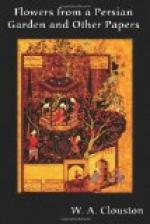[81] In a manuscript preserved in
the Lambeth Palace Library,
of
the time of Edward IV, the height of Moses is said
to
have
been “xiij. fote and viij. ynches and half”;
and
the
reader may possibly find some amusement in the
“longitude
of men folowyng,” from the same veracious
work:
“Cryste, vj. fote and iij. ynches. Our Lady,
vj.
fote
and viij. ynches. Crystoferus, xvij. fote and
viij.
ynches.
King Alysaunder, iiij. fote and v. ynches.
Colbronde,
xvij. fote and ij. ynches and half. Syr Ey.,
x.
fote iij. ynches and half. Seynt Thomas of
Caunterbery,
vij. fote, save a ynche. Long Mores, a man
of
Yrelonde borne, and servaunt to Kyng Edward the
iiijth.,
vj. fote and x. ynches and half.”—Reliquae
Antiquae,
vol i, p. 200.
IV
MORAL AND ENTERTAINING TALES.
If most of the rabbinical legends cited in the preceding sections have served simply to amuse the general reader—though to those of a philosophical turn they must have been suggestive of the depths of imbecility to which the human mind may descend—the stories, apologues, and parables contained in the Talmud, of which specimens are now to be presented, are calculated to furnish wholesome moral instruction as well as entertainment to readers of all ranks and ages. In the art of conveying impressive moral lessons, by means of ingenious fictions, the Hebrew sages have never been excelled, and perhaps they are rivalled only by the ancient philosophers of India. The significant circumstance has already been noticed (in the introductory section) that several of the most striking tales in European mediaeval collections—particularly the Disciplina Clericalis of Petrus Alfonsus and the famous Gesta Romanorum—are traceable to Talmudic sources. Little did the priest-ridden, ignorant, marvel-loving laity of European countries imagine that the moral fictions which their spiritual directors recited every Sunday for their edification were derived from the wise men of the despised Hebrew race! But, indeed, there is reason to believe that few mere casual readers even at the present day have any notion of the extent to which the popular fictions of Europe are indebted to the old Jewish Rabbis.
Like the sages of India, the Hebrew Fathers in their teachings strongly inculcate the duty of active benevolence—the liberal giving of alms to the poor and needy; and, indeed, the wealthy Jews are distinguished at the present day by their open-handed liberality in support of the public charitable institutions of the several countries of which they are subjects. “What you increase bestow on good works,” says the Hindu sage. “Charity is to money what salt is to meat,” says the Hebrew philosopher: if the wealthy are not charitable their riches will perish. In illustration of this maxim is the story of




